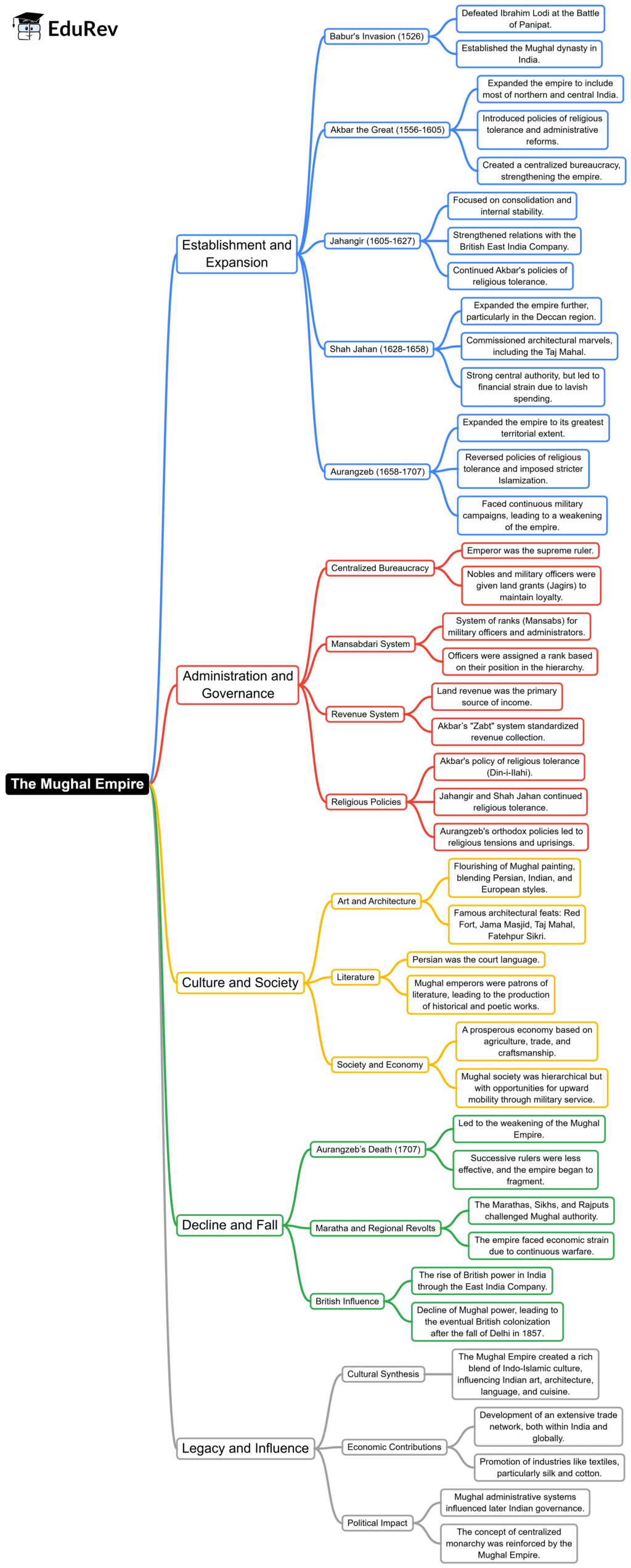UPSC Exam > UPSC Notes > History for UPSC CSE > Mind Map: The Mughal Empire
Mind Map: The Mughal Empire | History for UPSC CSE PDF Download

The document Mind Map: The Mughal Empire | History for UPSC CSE is a part of the UPSC Course History for UPSC CSE.
All you need of UPSC at this link: UPSC
|
122 videos|653 docs|168 tests
|
FAQs on Mind Map: The Mughal Empire - History for UPSC CSE
| 1. What were the main achievements of the Mughal Empire in terms of art and architecture? |  |
Ans. The Mughal Empire is renowned for its remarkable contributions to art and architecture, which blended Persian, Indian, and Islamic styles. Key achievements include the construction of iconic structures such as the Taj Mahal, a symbol of love and architectural brilliance, built by Shah Jahan. The empire also saw the development of intricate miniatures, beautiful textiles, and exquisite jewelry. Additionally, the Mughal gardens, characterized by their symmetrical layouts and water features, exemplify the aesthetic principles of the time.
| 2. How did the administrative structure of the Mughal Empire function? |  |
Ans. The administrative structure of the Mughal Empire was highly centralized yet allowed for regional autonomy. The emperor held supreme authority, supported by a hierarchy of officials known as nobles or 'mansabdars' who were responsible for military and administrative duties. The empire was divided into provinces or 'subahs,' each governed by a subahdar. A system of revenue collection was established, which included the 'zamindari' system, where local landlords collected taxes from peasants and paid a portion to the empire.
| 3. What role did religion play in the Mughal Empire? |  |
Ans. Religion played a significant role in the Mughal Empire, where the emperors adopted a policy of religious tolerance, especially under Akbar. He promoted a syncretic faith known as Din-i Ilahi, aimed at fostering unity among different religious communities. The empire was predominantly Islamic but also included Hindus, Sikhs, and Jains. This religious pluralism contributed to the cultural diversity of the empire, although religious tensions occasionally surfaced, especially with the later rulers who were less tolerant.
| 4. What were the causes of the decline of the Mughal Empire? |  |
Ans. The decline of the Mughal Empire can be attributed to several interrelated factors. These include weak leadership following the reign of Aurangzeb, who expanded the empire extensively but faced numerous challenges. The economic strain of constant military campaigns, coupled with administrative inefficiency and corruption, weakened the central authority. Additionally, growing regional powers, such as the Marathas and Sikhs, and the increasing influence of European colonial powers further destabilized the empire, leading to its eventual fragmentation.
| 5. How did the Mughal Empire influence modern India? |  |
Ans. The Mughal Empire has had a lasting influence on modern India in various aspects, including culture, cuisine, language, and architecture. The blending of Persian and Indian cultures during the Mughal period gave rise to a rich artistic heritage that is still evident today. The use of Urdu, which evolved from Mughal interactions, remains a significant language in India and Pakistan. Furthermore, Mughal architectural styles continue to inspire contemporary designs, and traditional Indian cuisine retains many Mughal influences, particularly in the use of spices and cooking techniques.
Related Searches
















